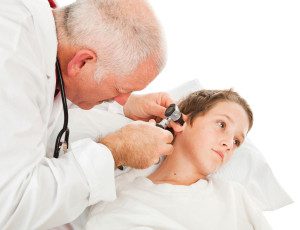One of the most dreaded hand signals in all of mom-kind is the ear tug. It signifies the fussiness, crying, pain, and sleeplessness that accompany one of childhood’s most common ailments – the ear infection.
Inhabiting the small pocket of air behind the eardrum, the middle ear is especially susceptible to infection for young children because of their smaller tubes. When germs get caught in the middle ear, the body fills it with fluid to fight the germs, causing pus to build up and the ear to feel full and painful. When your little one pulls on their ear it’s because they feel like their eardrum might pop like a balloon at any minute. Ouch!
By Julianna Hale
Full PDF here.
 Ear Infection Causes
Ear Infection Causes
Ear infections are not contagious. They often follow a cold, upper respiratory infection, or allergies, and are caused by bacteria and viruses. These common conditions block the Eustachian tube, causing germs to grow inside of the middle ear that can create a secondary infection.
Signs and Symptoms:
Spotting an Ear Infection
The most common sign of an ear infection is pain in the ear. Moms with young babies can spot this by the tell-tale ear pull followed by distress and crying. Older children will tell you that they have pain in their ears and act irritable and tired. “Symptoms can sometimes be a fever and nothing else. Kids can also have decreased activity or could not be eating like they should – they stop eating and playing because they’re in pain. Most parents come in and say children are pulling on their ears and are just not themselves,” says Tracy


Physicians Care
Gartman, a nurse practitioner with Physicians Care.
Ear infections are often accompanied by a fever, headache, loss of appetite, and trouble sleeping. If the eardrum bursts, fluid may leak from the ear. Sometimes children also exhibit trouble hearing and balance difficulties due to the change in equilibrium caused by the swelling.
When to Seek Professional Help
If you’re the kind of mom who has the pediatrician on speed dial, you’re not alone. Most moms believe that an ear infection requires a trip to the doctor in order to heal and, a good deal of the time, they’re right. If your child is tugging on his or her ear incessantly and crying even when comforted, make an appointment. If the ears are hot to the touch, there is obvious hearing impairment, discharge is coming out of the ear, a foreign object has become lodged in the ear, or if your child has a fever of 102 degrees F or higher, see a pediatrician.
If none of these conditions apply, your child has exhibited mild pain in the ear for 48 hours or less, and their temperature remains below 102.2 F, the American Academy of Pediatrics recommends a wait-and-see approach in which parents give the infection time to clear up without antibiotics or other treatments. “Seeing a doctor right away is not a bad plan, but wait-and-see is very advisable and wise. After the three-day limit, bring your child back or call your pediatrician if symptoms and a high-grade fever persist,” explains Dr. Todd Rudolph, a physician at Doctor’s Express.


Antibiotic therapy is one of the most common treatments for ear infections and will be prescribed on a case-by-case basis by the child’s doctor. But don’t rush to antibiotics if they are not absolutely necessary. “The most important thing parents need to know is that kids do not need to be on antibiotics every time they have an ear ache or ear infection. Many ear infections will resolve on their own without antibiotics,” says Dr. Rudolph.
For children with recurrent ear infections (three episodes in a six month period or four episodes in a year), inserting ear tubes to drain fluid from the middle ear may be necessary for relief. This outpatient procedure involves a doctor creating a tiny hole in the eardrum and placing a tube in the opening to help ventilate the middle ear and prevent fluid from accumulating.
Pain Relief


You can help ease your child’s pain in the throes of an ear infection by keeping their head elevated, giving them acetaminophen or ibuprofen, using a cool, moist compress, or using over-the-counter ear drops. Older children can chew gum to encourage swallowing and babies should be encouraged to drink frequently, which helps open the Eustachian tube. According to Dr. Rudolph, alternating children’s Tylenol and Advil every three hours is a good way to keep pain and fever down. “You may very well find that you’re able to work your child through the infection in that fashion,” he says.
Prevention
Aside from putting your child in a plastic bubble, there is really no way to prevent them from getting ear infections. There are, however, risk factors for developing ear infections that parents should know and work to avoid.
Common sense techniques for flu and cold prevention – frequent hand washing, avoiding contact with people who appear sick, and getting the flu vaccine – all help with prevention since these illnesses often lead to ear infections. In addition, it is critical that children are not exposed to smoking. “If a child is exposed to smoking they could have an allergic response, making them more likely to get an ear infection,” says Gartman. “The exposure could contribute to asthma or an upper respiratory infection, which can be a precursor to ear infections.”
“For kids who have a lot of chronic nasal infections or sore throats it’s a good idea to use nasal saline to help keep their nasal passages from getting clogged,” explains Dr. Rudolph. “This will help keep mucus moving. Also, getting children immunized will help guard against some of the more dangerous organisms that can cause sickness.” Breastfeeding also offers some protection.
Chronic Infections
Moms who are at their wit’s end in dealing with the misery of chronic ear infections should discuss seeing an Ear, Nose and Throat doctor (ENT) with their pediatrician. These physicians can discuss treatment options, such as ear tubes and adenoid removal, for severe cases.
Ear infections and small children go hand in hand. Taking preventative measures, using the treatment recommendations listed in this article, and seeking help from one of the Tennessee Valley’s many capable health professionals can give both parents and their children the relief they deserve.

